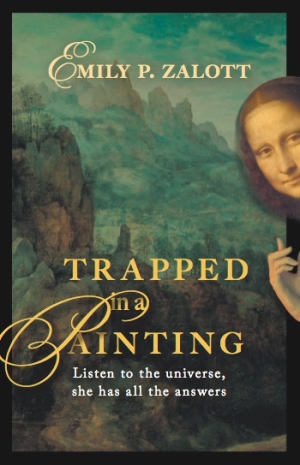Trapped in a Painting
Listen to the Universe, She Has All the Answers
Heartbreaking scenes are balanced with heartwarming ones to illuminate the ups and downs of a life lived to the fullest in the entertaining memoir Trapped in a Painting.
Emily P. Zalott’s memoir Trapped in a Painting tells the traumatic story of her unhappy marriage with humor and grace.
Zalott, who once felt lost in a life of her ex-husband’s making, explains how her upbringing led to that situation: she was a tomboy who loved hockey and felt overshadowed by her free-spirited older sister; rowing led to her meeting Leo. She married Leo when she was young, despite her second thoughts, and they were married for twenty-four years.
Following their wedding, Zalott moved into the home that Leo adored and that she hated. His personality changed; he became possessive of money, and he began to treat her as his subordinate rather than his equal. Though she left him after two years, she returned at the behest of her mother. The couple had three daughters. Zalott left again when she was in her forties and her children were young adults. In the wake of her divorce, she learned to be herself again; she remarried.
The narration is friendly, empathetic, and casual, acknowledging the surrealness of the stressful experiences it records and using humor to address the weirdness of marriage, motherhood, and aging. It has the flavor of gossip at times, revealing juicy details and taking embarrassment in stride. Hilarious observations bring an atmosphere of joviality to tense moments: Zalott is recorded sucking down a cocktail “like a vampire on a bender” on a nerve-wracking first date, and claims that one disastrous babysitting gig was the only experience she had with children before having her own “unless [she] hit them with [her] bike.” The personalities of the other individuals in the memoir are addressed in the same expressive style, covering both their negative and positive traits.
However, the book’s misspellings confuse the meaning of some lines, forcing second reads, and it is heavy-handed with some of its messaging. For example, the book focuses on Zalott’s childhood and teenage years for considerable space before reaching its main topic, using them, along with sections of exposition, to reinforce ideas about following one’s intuition, having gumption when others try to assert control, and being vulnerable with those you trust; these same notions are woven throughout the book.
Heartbreaking scenes are balanced with heartwarming ones to illuminate the ups and downs of a life lived to the fullest in the entertaining memoir Trapped in a Painting, about a divorcee’s growth toward an eventual, healthy relationship.
Reviewed by
Aimee Jodoin
Disclosure: This article is not an endorsement, but a review. The publisher of this book provided free copies of the book and paid a small fee to have their book reviewed by a professional reviewer. Foreword Reviews and Clarion Reviews make no guarantee that the publisher will receive a positive review. Foreword Magazine, Inc. is disclosing this in accordance with the Federal Trade Commission’s 16 CFR, Part 255.

